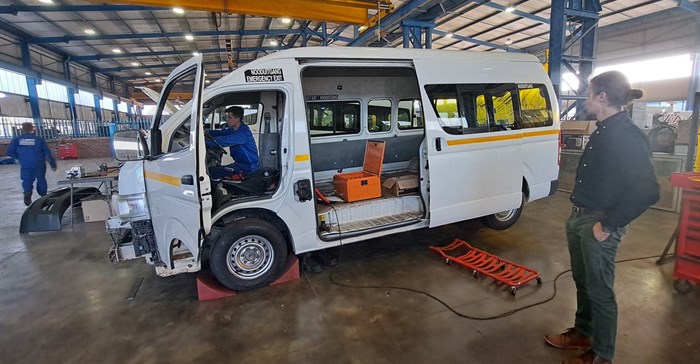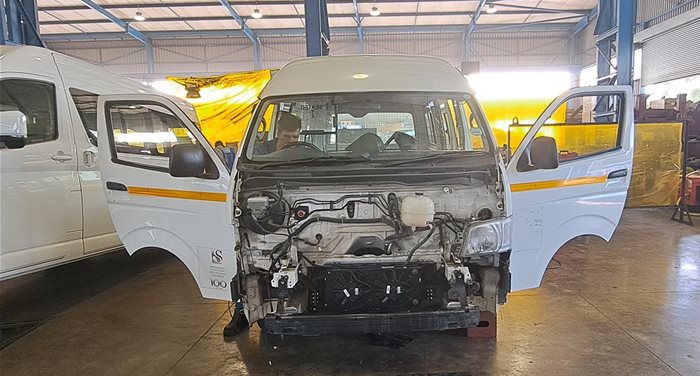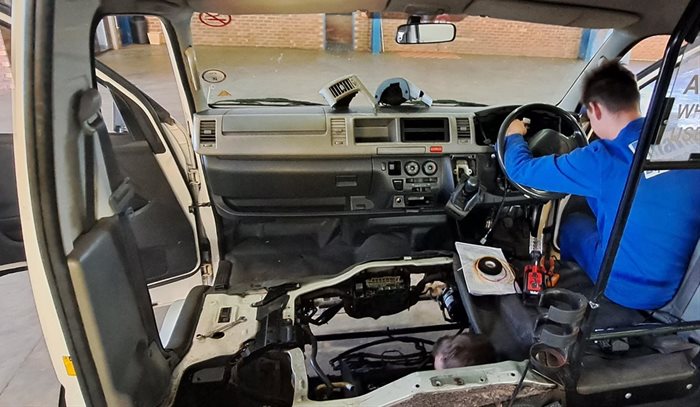
The project was funded by the South African National Energy Development Institute (Sanedi) and supported by Transport Services at SU, which donated a minibus for the conversion. Project lead, Prof Thinus Booysen of the Department of Industrial Engineering at SU, says the first retrofitted minibus is just the beginning.
“More than 70% of the trips in South Africa are by minibus in the informal sector, which is why we are hoping to encourage the retrofitting of some of the 250,000 minibuses in the country with electric propulsion. These will be cheaper and much more environmentally friendly than new electric vehicles," Booysen explains.
“With this venture, we want to help build the skills that will be needed to manufacture electric vehicles locally and also create awareness about how much we could save with electric taxis.”
The feasibility research began in June 2022 when a project team consisting of GoMetro, MiX Telematics, HSW, ACDC Dynamics, and various entities within Stellenbosch University’s Faculty of Engineering came together to conduct rigorous and extensive testing in and around the town of Stellenbosch. There was also a goal to put the electrification of the minibus taxi sector firmly on the national agenda through hosting an educational roadshow in all nine provinces in the course of 2023.
Kevin Reynders, CEO of Rham Equipment, says “Groundbreaking innovation and local skills development are at the core of our company’s ethos. Working on this project with Stellenbosch University allowed us to plough back into engineering students' development and to contribute to sustainable mobility in South Africa's dynamic vehicle landscape.”
One of Booysen’s team members, Stephan Lacock, who is doing his master’s degree in electronic engineering at SU and funded by Golden Arrow, helped designed the retrofitted minibus with partners at Rham Equipment.
Lacock says they removed the minibus’ internal combustion engine and its associated components such as the petrol tank, manual transmission, gas pipe, and radiator. He adds that throughout the development process, the retrofit needed to comply with national road safety regulations, particularly the strict requirement not to make any permanent changes to the minibus chassis (base frame), such as drilling or welding and specific weight requirements.

“Overcoming design challenges, Rham Equipment and our research team have successfully created a reproducible ‘kit’ that includes the main components of the electric powertrain or system that propels the vehicle forward. These include an electric motor, inverter, charger, electronic control unit, and a single-speed reduction gearbox. The powertrain is skilfully connected to a custom-designed battery pack that meets the specific operational needs of a minibus.”
Lacock says one of the standout features of the retrofitted minibus is its advanced regeneration system which harnesses energy generated during deceleration and downhill driving, enhancing the vehicle’s energy efficiency and overall range.
“As a result, the minibus is now equipped to travel an estimated range of approximately 120km, with a maximum speed of 120km/h. It has an electric motor power of 90kW and a battery capacity of 53.76kWh," he explains. "This ensures that it meets all load and driving requirements comparable to those of traditional internal combustion engine minibuses. Moreover, the electric powertrain brings enhanced agility and an exhilarating driving experience to the minibus.”
Recharging remains the biggest challenge in the EV transition, with electric cars needing long periods of downtime to charge. Lacock believes that the team has solved this issue as well.
“Thanks to the inclusion of a 20kW charger, the minibus can be efficiently charged in just over two hours,” he says.
Although Booysen is optimistic about the retrofitting of taxis, he is also mindful of the challenges related to powering them in a country where the national grid already operates at half its capacity.
“We need to look at what the impact would be if we add an extra load of electric vehicles to the grid. Given that people who can buy electric vehicles can also afford to install fast charges, the impact of those vehicles will quickly slay a grid already on its knees,” he says.
“With petrol and diesel vehicles we could drive to the nearest gas station because there was adequate infrastructure, sufficient ‘range’ on a tank, and the refilling was quick. With electric vehicles, the problem is the ‘filling’ takes a long time, and the range and energy source are limited.”

Echoing Booysen’s sentiment, PhD student and team member Johan Giliomee says the expected charging times that result from the way minibus taxis operate is a concern because of the additional load the simultaneous charging will put on the grid.
“Research results show that electrifying all minibus taxis in South Africa could add a load of 5% of what the grid can currently deliver. As most taxis have similar operational hours, peaking before and after the workday, their charging opportunity window also aligns. This will result in a significant peak power draw that needs to be accounted for when planning for the electrification of the minibus taxi sector. In addition, the total energy required for a given operational period also requires in-depth analysis.”
Giliomee points out that minibus taxis could be supplied with electricity through the installation of solar panels and battery energy storage systems at taxi ranks. Hydrogen could also be used as an alternative electricity source or for interim energy storage.
“The vast majority of taxis are stationary between the early morning and afternoon peaks, making it an ideal opportunity for charging from solar panels. This also means a single charge would only need to supply sufficient energy for half the day, significantly reducing the required battery capacity as opposed to being scaled to support a full day's operations. Further ideal charging opportunities are seen overnight when the national electricity demand is at its lowest.”
Given the current severe electricity constraints, Booysen suggests we move the national discussion from electric vehicles to a system-perspective of electric mobility to include the decentralised provision of electricity.
“We must think anew about how we buy a car; it must be sold as part of a mobility package, that is, the car, solar panels and a large battery as a system, rather than just an electric car that will mess up our grid and will be restricted by our grid.”
Booysen says in the next phase of the project they will collaborate with Rham and Golden Arrow Bus Service to retrofit one of the company’s buses.